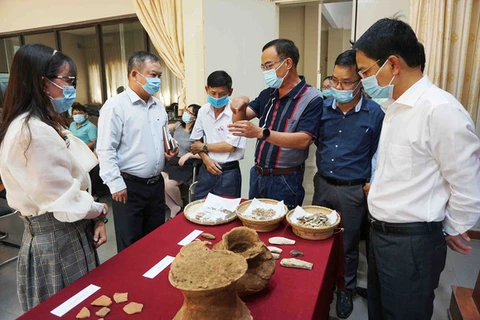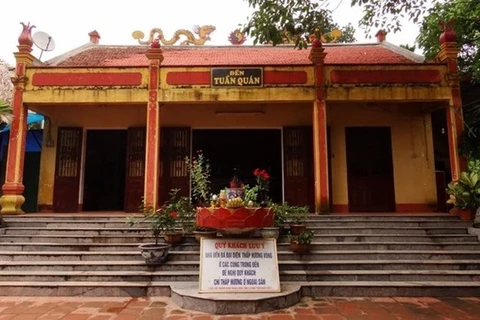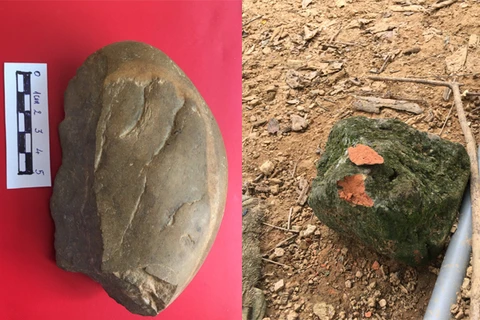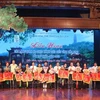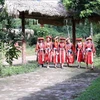Ninh Binh (VNS/VNA) - New large archaeological excavations are expected to start this month in the northern province of Ninh Binh's Hoa Lu district, home of the Hoa Lu Ancient Capital.
The excavations are to be conducted on a total area of 600sq.m from September 15 to December 31 this year following a decision by the Ministry of Culture, Sports and Tourism (MoCST) issued recently on its website.
According to the decision, the ministry has assigned Ninh Binh province's Department of Culture and Sports in coordination with the Institute of Archeology to unearth the two locations – a field south of King Le Dai Hanh Temple and a site near the wall of Thanh Den (Den Citadel) in Truong Yen commune, Hoa Lu district.
Dr Nguyen Ngoc Quy from the Institute of Archeology was assigned to preside over the excavations.
MoCST also said during the excavations, units granted licences to undertake the work should pay attention to protecting the stratigraphy of the relics and be responsible for disseminating information to local people about the protection of cultural heritage in the areas.
They should not announce any official archaeological conclusions or results without agreement from authorities and the Department of Cultural Heritage, the MoCST said.
"Artefacts collected during the excavation must be transferred to Ninh Binh Provincial Museum for protection and preservation. The provincial Department of Culture and Sports is responsible for receiving, managing, and reporting to the Minister of MoCST about plans to protect and promote the value of those artefacts," according to the ministerial decision.
After completing the excavation, the department and the Institute of Archeology must make a preliminary report and propose a plan for management and protection of the excavated area within a month and submit a scientific report within a year to the MoCST, the decision said.
Workshop reviews archaeological research
Earlier in April, a workshop was held by the provincial Department of Culture and Sports, the Institute of Archaeology, and the Vietnam Academy of Social Sciences reviewing archaeological excavation and research at the ancient capital of Hoa Lu and other sites in Ninh Binh province.
Held as part of activities responding to the Visit Vietnam Year 2021, participants at the workshop lauded the results of the endeavour, saying it had contributed to preserving and promoting the values of cultural heritage in the province.
The excavation work revealed unique architecture at Hoa Lu, which vividly reflects national construction and defence as well as royal cultural life, and the formation and development of the locality’s administrative system during the 10th century.
Five excavation areas and three exploration pits on a total area of 300 sq.m were studied, revealing architectural layers from the Dai La and Dinh – Le (early Le) dynasties.
At brick tombs in Nho Quan and Gia Vien districts, initial research results noted that these were tombs from the Eastern Han Dynasty, proving the development of culture, economy, and politics and clarifying how Hoa Lu was established and developed.
Research results initially recognised that the inner city of Hoa Lu in the 10th century had a much larger distribution area of architectural works than experts and researchers previously imagined.
At the workshop, research and excavation units proposed adjustments to land use planning and the detailed plan for the conservation - embellishment and promotion of specially-protected areas in the ancient capital, which were approved by the provincial People’s Committee in 2009, to serve research, excavation, and conservation in the future./.
The excavations are to be conducted on a total area of 600sq.m from September 15 to December 31 this year following a decision by the Ministry of Culture, Sports and Tourism (MoCST) issued recently on its website.
According to the decision, the ministry has assigned Ninh Binh province's Department of Culture and Sports in coordination with the Institute of Archeology to unearth the two locations – a field south of King Le Dai Hanh Temple and a site near the wall of Thanh Den (Den Citadel) in Truong Yen commune, Hoa Lu district.
Dr Nguyen Ngoc Quy from the Institute of Archeology was assigned to preside over the excavations.
MoCST also said during the excavations, units granted licences to undertake the work should pay attention to protecting the stratigraphy of the relics and be responsible for disseminating information to local people about the protection of cultural heritage in the areas.
They should not announce any official archaeological conclusions or results without agreement from authorities and the Department of Cultural Heritage, the MoCST said.
"Artefacts collected during the excavation must be transferred to Ninh Binh Provincial Museum for protection and preservation. The provincial Department of Culture and Sports is responsible for receiving, managing, and reporting to the Minister of MoCST about plans to protect and promote the value of those artefacts," according to the ministerial decision.
After completing the excavation, the department and the Institute of Archeology must make a preliminary report and propose a plan for management and protection of the excavated area within a month and submit a scientific report within a year to the MoCST, the decision said.
Workshop reviews archaeological research
Earlier in April, a workshop was held by the provincial Department of Culture and Sports, the Institute of Archaeology, and the Vietnam Academy of Social Sciences reviewing archaeological excavation and research at the ancient capital of Hoa Lu and other sites in Ninh Binh province.
Held as part of activities responding to the Visit Vietnam Year 2021, participants at the workshop lauded the results of the endeavour, saying it had contributed to preserving and promoting the values of cultural heritage in the province.
The excavation work revealed unique architecture at Hoa Lu, which vividly reflects national construction and defence as well as royal cultural life, and the formation and development of the locality’s administrative system during the 10th century.
Five excavation areas and three exploration pits on a total area of 300 sq.m were studied, revealing architectural layers from the Dai La and Dinh – Le (early Le) dynasties.
At brick tombs in Nho Quan and Gia Vien districts, initial research results noted that these were tombs from the Eastern Han Dynasty, proving the development of culture, economy, and politics and clarifying how Hoa Lu was established and developed.
Research results initially recognised that the inner city of Hoa Lu in the 10th century had a much larger distribution area of architectural works than experts and researchers previously imagined.
At the workshop, research and excavation units proposed adjustments to land use planning and the detailed plan for the conservation - embellishment and promotion of specially-protected areas in the ancient capital, which were approved by the provincial People’s Committee in 2009, to serve research, excavation, and conservation in the future./.
VNA


